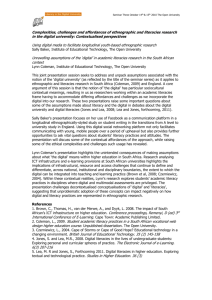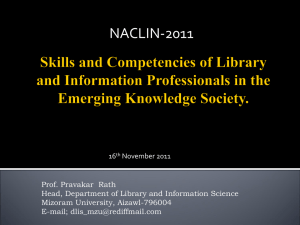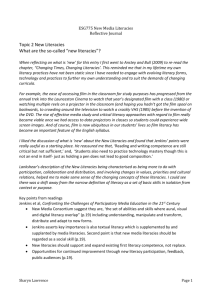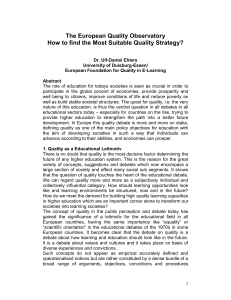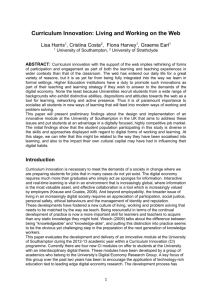conf_P_209_acecpres
advertisement
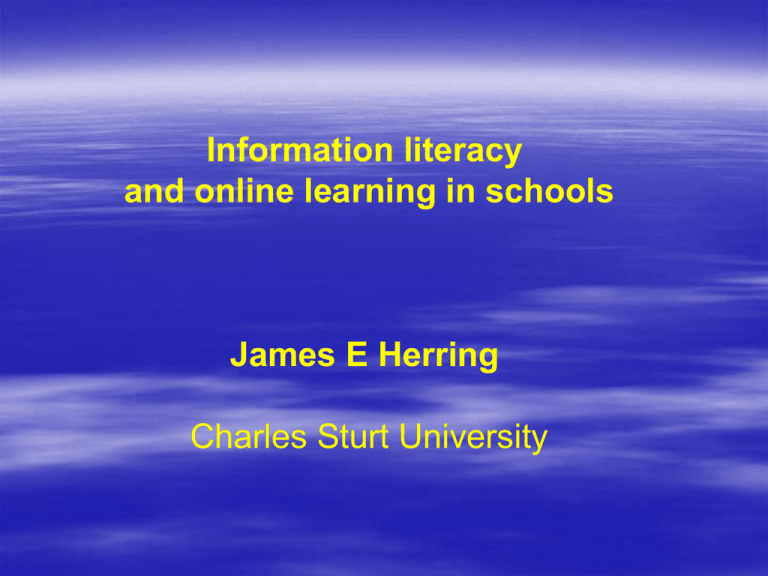
Information literacy and online learning in schools James E Herring Charles Sturt University Questions What are the key information - related literacies that relate to e-learning? How might an information literacy model be used in e-learning? How can we integrate information literacy into elearning? How can teachers and teacher-librarians collaborate in e-learning? Key information - related literacies 1 http://www.kn.sbc.com/wired/21stcent/index.html Key information - related literacies 2 Today's readers become literate by learning to read the words and symbols in our world and its antecedents. They must analyze, compare, evaluate and interpret multiple representations from a variety of disciplines and subjects, including texts, photographs, artwork, and data. Debbie Abilock http://www.noodletools.com/debbie/consult/present/IRA_files/frame.htm Key information - related literacies 3 http://www.metiri.com/features.html Information literacy How does this process relate to E-learning? Reflect On process Organise, write or present Thinking about learning Identify Purpose or need Information Literacy Reflect and take notes Mindstorm/ concept map Pose questions Read, understand evaluate Locate sources Information-related literacies and e-learning Information skills Student learning Multimedia resources E-learning format Task : To integrate information skills into e-learning formats to provide students with a scaffold – but how? Information Literacy – the PLUS model Purpose - Identifying exactly what the topic is about - Exploring existing knowledge - Using thinking skills in brainstorming and concept mapping - Formulating questions Information Literacy – the PLUS model Location Ability to find relevant information in a range of different sources Selection skills in assessing the relevance of an information resource ICT skills using electronic resources such as the web Information Literacy – the PLUS model Use Reading and understanding skills Selection and evaluation skills Recording and synthesising skills Writing and/or presentation skills Information Literacy – the PLUS model Self-evaluation Reflecting on the process Identifying areas of improvement Transferring skills? PLUS model - examples Name of Religion: ......................... Name of rite of passage at death: Sources of information ............................ .......... When does the ceremony to mark the rite of passage take place? What happens in place of worship (religious building)? Why? Does anything happen in the home? why? Is their any special food that is eaten? Why? Are any special clothes worn? Why? Why is this ceremony important for people of this faith? Location: List all the sources of information you have used for this section - ` following the format of the example used below Website author Website title URL Hinchingbrooke School Need to know Teachers and Parents UNITS ONE TWO THREE FOUR FIVE SIX SEVEN 8-10 EVALUATE Unit 7 level 7-8 7. Keywords, contents, indexes, data bases, search engines Searching in a book, a catalogue and an online search engine all need the same thing first you must have an idea of what you are looking for. Searching in a book you might look at the contents (at the front) first to find if there is a whole chapter on your subject. You might look in the index (at the back) to look for specific references to your subject. A search engine searches a data base of information collected by a person who selects by using their intelligence or by a robot which visits online sites automatically. http://www.putlearningfirst.com/infohand/u7.html Teacher and teacher-librarian cooperation Linlithgow Academy, Scotland (est 1894) Linlithgow Grammar – 17th Century Discipline in those early days was brutal. Flogging with a rod or the tawse, public humiliation or ducking the head in a bowl of stale porridge: all were examples of the rigorous control exercised over a class which could number up to 100 pupils. The school day started at 5.00am and lasted for 10 hours, with most lessons being conducted in Latin. Teacher and teacher-librarian cooperation Librarian’s web skills Instructional website Teacher’s subject knowledge Parent helper Argumentative and Discursive/Persuasive Writing What you have to do. Summary We can now sum up the dangers to be avoided: 1. Lack of knowledge of and interest in the subject. 2. Disorganisation. 3. Direct abuse. 4. Illogical leaps. 5. Sweeping generalisations. Related topics: Bloodsports, Endangered species, Factory farming, Fur trade, Zoos http://learn.co.uk/yvote/debates/debates7.htm A short essay explaining why animals are important for medical research http://learn.co.uk/yvote/debates/debates8.htm A short essay arguing against the use of animals in experiments www.cofe.anglican.org/view/index.html The Church of England’s view on animal rights http://re-xs.ucsm.ac.uk/ethics/animal_rights.html The ethics and moral issues relating to animal welfare are looked at through a number of links from this site for schools Current study Ask the What they think of Questionnaire Did they like this form of learning? Did they get enough help? Would they rather use a search engine? How did they feel about doing the assignment at different stages? Conclusions E-learning is here to stay Students need a scaffold Will students feel less safe with e-learning? Conclusions An information literacy model MAY provide a scaffold How will we know? – ask the students

